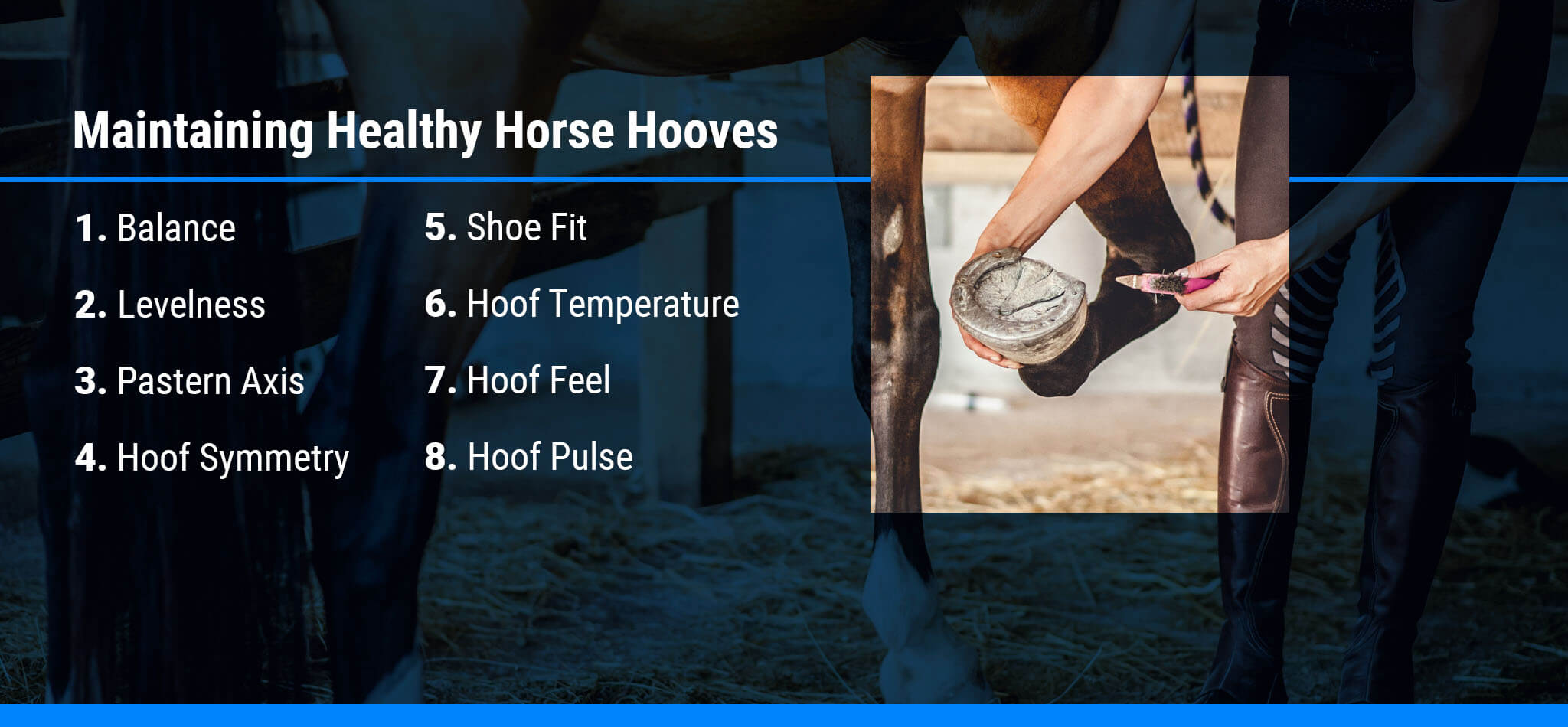Promoting Hoof Health in Horses
Your horse’s hooves play a key role in its mobility and well-being. Hooves support a horse’s balance, movements and daily tasks. Like fingernails, hooves experience growth that prompts regular maintenance. Wild horses experience this maintenance naturally. As they run and travel each day, they wear down hoof growth and adapt to their landscape without the need for extra care. Maintaining hoof health is key for your horse to thrive.
Table of Contents
- Anatomy of a Horse Hoof
- Natural Hoof Use & Growth
- Maintaining Healthy Hooves
- Supporting Your Horse’s Hoof Health
In domestic settings, horses have living conditions that do not provide natural hoof shaping. Life in a paddock, corral or fenced field differs from the mobility and space a wild horse encounters. Accordingly, promoting your horse’s hoof health involves several adaptations that address hoof needs and the horse’s environment.
Anatomy of a Horse Hoof
Your horse’s hoof anatomy helps support overall hoof wellness and your horse’s mobility. The three main components of an equine hoof are the wall, sole and frog:
- Wall: This part of the hoof is visible when the horse is standing. The wall has a horn-like material that grows and does not contain nerves or blood vessels. Hoof walls separate into three sections, including the toe, quarters and heel. On a horse’s front feet, the wall is thickest at the toe, whereas the hind feet have a more uniform thickness.
- Sole: The sole is visible when a horse lifts its hoof off the ground. This part of the foot has a concave shape that prevents it from touching the ground. The surface of a hoof sole is made from dead, insensitive tissues that protect sensitive tissues underneath.
- Frog: This hoof component is wedge-shaped and is usually the first part of the hoof to make contact with the ground. When a horse takes a step, its weight presses down directly above the frog. The frog aids in shock absorption and helps promote blood flow through the leg.
Natural Hoof Use & Growth
The column of bones in your horse’s leg acts like a pump for optimal shock absorption. As your horse puts weight onto a foot, the frog pushes upward and expands the heel. This compresses the digital cushion in the center of the hoof, which causes the blood in the hoof to travel up the leg. When the horse lifts its foot, blood returns to the area. This process enables the horse to support its weight and encourages healthy circulation.
Hoof use is one of several factors that plays into horse hoof growth. Wall growth can change due to the following circumstances:
- Age of the horse: Young horses may experience faster growth than older horses.
- Weather conditions: Horse hooves grow slower in the winter than they do in warmer months.
- Horse’s environment: Horses that live in soft pastures will experience quicker hoof growth than horses kept in rockier environments that wear down hooves.
- Activity level: Well-exercised horses tend to have healthier hooves that experience more growth.
It is natural for these factors to shift and change throughout your horse’s life. You may have greater control over some factors like the horse’s nutrition, environment and activity level. As factors change, you can support your horse’s hoof health by adapting your care routine.
Uncontrollable circumstances like the weather can impact hoof growth. For example, dry weather or frequent shifts from wet to dry weather could cause cracks in hooves.
Maintaining Healthy Hooves

For many horses, shodding helps maintain natural hoof growth and health. As you provide this service, there are several indicators to look for to support healthy function and full mobility:
- Balance: A balanced hoof has equal medial and lateral sizes and shapes. View the hoof from the bottom and imagine a plus sign that runs vertically through the frog and horizontally across the center of the sole. These areas should remain balanced under the center of the hoof for optimal health.
- Levelness: During trimming, a healthy hoof should have a completely flat surface against the ground. In addition, the hoof wall should remain slightly higher than the sole so that it bears most of the horse’s weight
- Pastern axis: From the side, the hoof wall angle should form a parallel line with the pastern bone that runs through the leg.
- Hoof symmetry: Your horse’s front legs carry about 60% of its weight compared to its back legs. The back legs provide propulsion, and the hooves are shaped to do so. When trimming, the front legs and hind legs should form symmetrical pairs, respectively.
- Shoe fit: The horseshoes you affix should match the shape of the hoof, like an extension of the hoof wall. From the side, the shoe should be completely flat against the hoof. Shoes should allow for expansion at the heel when walking and avoid contact with the frog.
- Hoof temperature: Healthy hooves have a consistent temperature across all four feet. When you touch the hoof wall and coronet, each hoof should have an equal temperature.
- Hoof feel: A healthy hoof is flat and smooth with occasional ridges. If you know your horse experienced a change in hoof growth recently, ridges are a natural reflection of that shift.
- Hoof pulse: When you place your hands on either side of the fetlock, or ankle, you should feel a faint and slow pulse between the fetlock and coronet. This indicates overall hoof health.
Supporting Your Horse’s Hoof Health
Maintaining hoof health is an important aspect of your horse’s quality of life. As your horse interacts with its environment, it relies on healthy hooves to maintain proper leg function and stability. Understanding your horse’s hooves can help you promote its overall well-being.
